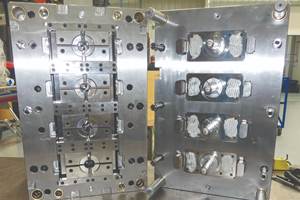Cold Runner Manifold with Center Gate Provides Easy Operation, Maintenance
A cold runner manifold system for thermoset injection molds has been developed to overcome the challenges that come with using cold runners.
A cold runner manifold system for thermoset injection molds has been developed to overcome the challenges that come with using cold runners. Binding, uneven flow and premature washout of mold contours are eliminated thanks to center gating with less surface obstruction, providing better flow and thus, a better quality part.
The process was designed by MoldMaking Technology’s 2007 Large Shop Leadtime Leader Chicago Mold Engineering Co. Inc. (CME, St. Charles, IL)—a manufacturer of multi-cavity injection molds and compression molds for the thermoset and thermoplastic industries for the past 62 years. According to CME Sales Manager Don Mazurek, “the unique characteristics of thermoset molding compounds and their increased popularity for automotive lighting reflectors mandated improvements on traditional cold runner systems. The system must keep the material evenly cooled to maintain its integrity until it reaches the heated mold cavity. Demanding applications like automotive reflector molds and thermoset appliance parts require flawless performance.”
Building the Manifold
With nominal expansion of 0.007” per inch in operation, binding can occur, shutting down valuable mold operation. To prevent binding, a variety of hardened steels strategically comprise the mold, including H13, 420 stainless steel, 4140, S7, and hot rolled steel. All surfaces are precision machined to tolerances of just tenths of a thousandth to ensure reliability. “Throughout the mold, any compromises in quality would be false economy in the critical performance of the system,” explains Mazurek.
The manifold may be built solid or split, with fully machined, tapered reduction flow channels for improved material flow. Solid manifolds are preferred because there is less chance of leakage from the high injection pressure. Removable inserts simplify cleanout. The water cooled manifold is placed into a tapered manifold pocket. During operation, the manifold is “pre-loaded” to ensure constant pressure during injection.
The Addition of Nozzles
CME also developed hardened S7 nozzles with stainless steel water jackets that are bolted together and have double O-rings to ensure they are leakproof. Mazurek points out that “while many mold builders weld the nozzles together, these nozzles can be disassembled and cleaned if and when they plug up.” The top of the nozzle has a spherical mating surface to shut off with the inserts that are bolted into the bottom of the manifold. Material flow may be easily adjusted by the hole diameter in the nozzle—depending upon the part size and the amount of space around the optic insert in the specific case of reflector molds. Operating temperature of the insert is one of the determining factors when sizing the nozzles.
Finally, a taper is added to the front of the nozzle, forming the gate. Material passes through the manifold to the nozzles, which are also water cooled inside the hot mold. A small insert located at the bottom of the manifold seals with the nozzle and maintains its seal because of the pre-load on the nozzle and the design of the insert. When the material hits the hot insert, it flows like water until the part is full. Then the gate cutter and any core pins are advanced forward to punch the holes and cut off the gate. Once the part is set, the mold opens, the part ejects along with a small sprue and the mold is ready for the next cycle.
Related Content
CAM Automation Increases Mold Production, Quality
Mold builder switches CAM software package after 20 years to take advantage of innovative programming strategies that reduce mold machining programming and processing times.
Read MoreCAD/CAM Software Reduces Delivery Times by 70% With a Six-Month ROI
Single integrated CAD/CAM package reduces translation errors, simplifies design process, improves shop efficiency and shortens tool lead times.
Read MorePrecision Welding Services Offer Rapid Turnaround Mold Repair and Reduced Molder Downtime
X-Cell Tool & Mold relies on outsourced, high-quality welding repairs from Lewis-Bawol Welding to ensure its customers' molds are back in production quickly and affordably.
Read MoreHow to Harness 3D Scanning for Mold Tool Repairs
3D scanning supports the repair of molds with no history, drawings or design files.
Read MoreRead Next
How to Evaluate Hot Runner Nozzless
The way to choose the right hot runner nozzle is to evaluate the entire molding system first.
Read MoreHow to Use Strategic Planning Tools, Data to Manage the Human Side of Business
Q&A with Marion Wells, MMT EAB member and founder of Human Asset Management.
Read MoreAre You a Moldmaker Considering 3D Printing? Consider the 3D Printing Workshop at NPE2024
Presentations will cover 3D printing for mold tooling, material innovation, product development, bridge production and full-scale, high-volume additive manufacturing.
Read More.jpg;maxWidth=970;quality=90)












.jpg;maxWidth=300;quality=90)








.jpg;maxWidth=970;quality=90)